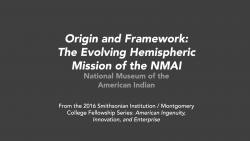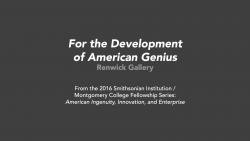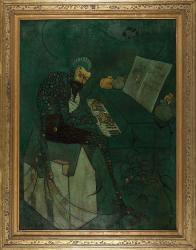Tess Porter
User Experience Strategist (she/her)
Smithsonian Office of Educational Technology
I'm the User Experience Strategist at the Smithsonian Office of Educational Technology. Here, I focus on the use of digital museum resources to support teaching and learning. My work draws on my experience as a museum educator, digital analyst, usability researcher, and content designer. I hold a B.A. in Anthropology and a B.A. in Art History from University Colorado Boulder, and an M.S. in Museums and Digital Culture with an Advanced Certificate in User Experience at Pratt Institute.
Tess Porter's collections
American Ingenuity, Innovation, and Enterprise: National Museum of American Indian Seminar Resources
<p>This collection previews the second seminar of the 2016 Montgomery College / Smithsonian Institution Fellowship seminar series. Fellows will visit the National Museum of the American Indian, tour the exhibition "The Great Inka Road: Engineering an Empire," and watch the documentary "Caravan of Memory." Dr. José Barreiro, Assistant Director for Research, Director of the Office for Latin America, and co-curator of "The Great Inka Road," will lead the seminar.</p>
<p>Included in this collection: bio of presenter, presentation description, and resources chosen by the presenter for attendees to explore before attending the session. These resources are not required, but will help fellows prepare for discussion the day of the seminar.</p><p>#MCteach<br /></p>
 Tess Porter
Tess Porter
6
American Ingenuity, Innovation, and Enterprise: Renwick Gallery Seminar Resources
<p>This collection previews the first seminar of the 2016 Montgomery College / Smithsonian Institution Fellowship seminar series. Fellows will visit the Renwick Gallery, the Smithsonian American Art Museum’s branch for contemporary craft and decorative art, which recently re-opened in November 2015 after an extensive two-year renovation. Two Renwick Gallery staff members will speak at this event: Nicholas Bell, Fleur and Charles Bresler Curator-In-Charge, and Nora Atkinson, Lloyd Herman Curator of Craft. </p>
<p>Included in this collection: presenter bios, presentation descriptions, and resources chosen by presenters for attendees to explore before attending the session. These resources are not required, but will help fellows prepare for discussion the day of the seminar.</p><p>#MCteach<br /></p>
 Tess Porter
Tess Porter
8
American Ingenuity, Innovation, and Enterprise: Opening Seminar Resources
<p>This collection previews the opening panel of the 2016 Montgomery College / Smithsonian Institution Fellowship seminar series. Three Smithsonian staff members will speak at this event: Tricia Edwards of the National Museum of American History, Doug Herman of the National Museum of the American Indian, and Josh Bell of the National Museum of Natural History.</p>
<p>Included in this collection: presenter bios, presentation titles and descriptions, and resources chosen by presenters for attendees to explore before attending the session. These resources are not required readings - instead, they provide guiding questions and background information to help prepare for discussion the day of the seminar.</p><p>#MCteach</p>
 Tess Porter
Tess Porter
12
Bob Dylan and Woody Guthrie: Teaching Resources
<p>This topical collection gathers resources about Bob Dylan, one of the most influential American music artists of the 20th century, and Woody Guthrie, who greatly influenced the work of Dylan and other folk artists. Ideas for classroom application located in "Notes to Other Users." Resources include images, videos, music, and a lesson plan.</p>
<p>Tags: minnesota; hibbing; folk music; medieval music; ballad; #SmithsonianMusic<br /></p>
 Tess Porter
Tess Porter
15
Minnesota: Investigating a Place
<p>This teacher's guide uses stamps, photographs, paintings, objects, videos, and music to explore the history and culture of Minnesota, Land of 10,000 Lakes. In the classroom, these resources can be used by students to investigate two essential questions: How do you define Minnesota as a place? What does it mean to be a Minnesotan? </p><p>Supporting questions and activity implementation ideas are located under this collection's Information (i) button.<br /></p>
 Tess Porter
Tess Porter
54
The Classical Origin of Iconic American Symbols
<p>In this student activity, analyze how and why iconic symbols of America, such as the Capitol Building and the United States Seal, were inspired by Greek and Roman art and architecture. </p>
<p>Explores the big ideas:</p>
<p></p>
<ul><li>How were symbols of America influenced by those of Ancient Greece and Rome? </li><li>What might this desire to associate America with historic, successful democracies say about early American hopes for their new nation?</li></ul><p></p>
<p>Includes: architecture, a seal, portraiture, a video, a primary source letter, discussion questions, and an opportunity to learn more through the full digitized text of "The Ruins of Palmyra," a publication that heavily inspired early American neoclassical architecture.</p>
<p>Keywords: greece, symbolism, classic, classical</p>
 Tess Porter
Tess Porter
12
Ancient Greek Myth: Reinterpreted by African American Artists
<p>In this student activity, analyze the timelessness of myth through three works of art by modern African American artists. Each artist, inspired by Ancient Greek myth, retells stories and reinterprets symbols to explore personal and universal themes. Includes three works of art, summaries of the myths they reference, and discussion questions. Also includes a video about the artist Romare Bearden and his series 'Black Odyssey,' which details Bearden's artistic process, the significance of storytelling in his art, and the lasting importance of 'Black Odyssey.'</p>
<p>Big Ideas: How does myth reflect the values of an individual or their culture? How do myths reflect the human experience? How do myths transcend time and place?</p>
<p>Inspired by a Smithsonian American Art Museum lesson plan, located <a href="https://americanart.si.edu/education/k-12/resources/african-american">here</a>.</p>
<p>Keywords: greece, alma thomas, bob thompson</p>
 Tess Porter
Tess Porter
6
Symbolism, Story, and Art: Achelous & Hercules
<p>A teacher's guide to the 1947 mural "Achelous and Hercules," by Thomas Hart Benton, which retells an Ancient Greek myth in the context of the American Midwest. Includes the painting, a pdf of the myth "Achelous and Hercules," a website, and video discussions by curators and educators. The website includes an interactive exploring areas of interest on the piece, as well as lesson and activity ideas for the classroom.</p>
<p>Lesson & Activity Pathways: how to analyze symbol and meaning in art and writing, Ancient Greek myth, creative writing, and creating art.</p>
<p>Keywords: greece, post-war, painting, agriculture, marshall plan, truman, missouri river</p>
 Tess Porter
Tess Porter
5
Looking at Ancient Civilization through Objects
<p>This teacher's guide provides suggestions for facilitating student investigation of archaeological remains. Includes examples of objects to use (Ancient Chinese oracle bones) and a handout on artifact analysis that adapts close reading strategies to explore cultural objects. This concept can be replicated for other artifacts and cultures.</p>
<p>Use the handout to brainstorm supporting questions for students - ie. "What knowledge or experience did the maker have?" "Who were the intended users?" Answers to these questions give students the knowledge to answer larger, compelling questions, like "What can archaeological remains reveal about early Chinese urban society?" </p>
<p>Keywords: China, archaeology, archaeologist</p>
 Tess Porter
Tess Porter
6
Mummies: Teaching Resources
<p>This topical collection pulls together resources on mummification in multiple cultures. Resources cover reasons for mummification, different methods, and what can be learned by studying mummies. Includes Smithsonian Channel videos, fact sheets, objects, a student-targeted webcast, and articles. Areas explored include Ancient Egypt, South America, and Europe.</p><p>Keywords: egyptian, archaeology</p>
 Tess Porter
Tess Porter
18
Homo floresiensis: Teaching Resources
<p>This topical collection gathers resources related to Homo floresiensis, commonly known as the Flores “Hobbit." H. floresiensis, was discovered in 2003, making it the second most recently discovered early human species. Contains a video, websites, a 3D interactive tour, and articles.</p><p>Keywords: physical anthropology</p>
 Tess Porter
Tess Porter
7
Pittsburgh & Place
<p>Includes iconic people, places, and things associated with Pittsburgh. In the classroom, these resources can be used by students to investigate two essential questions: How do you define Pittsburgh as a place? What does it mean to be a Pittsburgher? </p>
<p>Supporting questions and activity implementation ideas can be found by clicking the Information (i) button in the upper right. </p>
<p>Keywords: Pennsylvania </p>
 Tess Porter
Tess Porter
44









